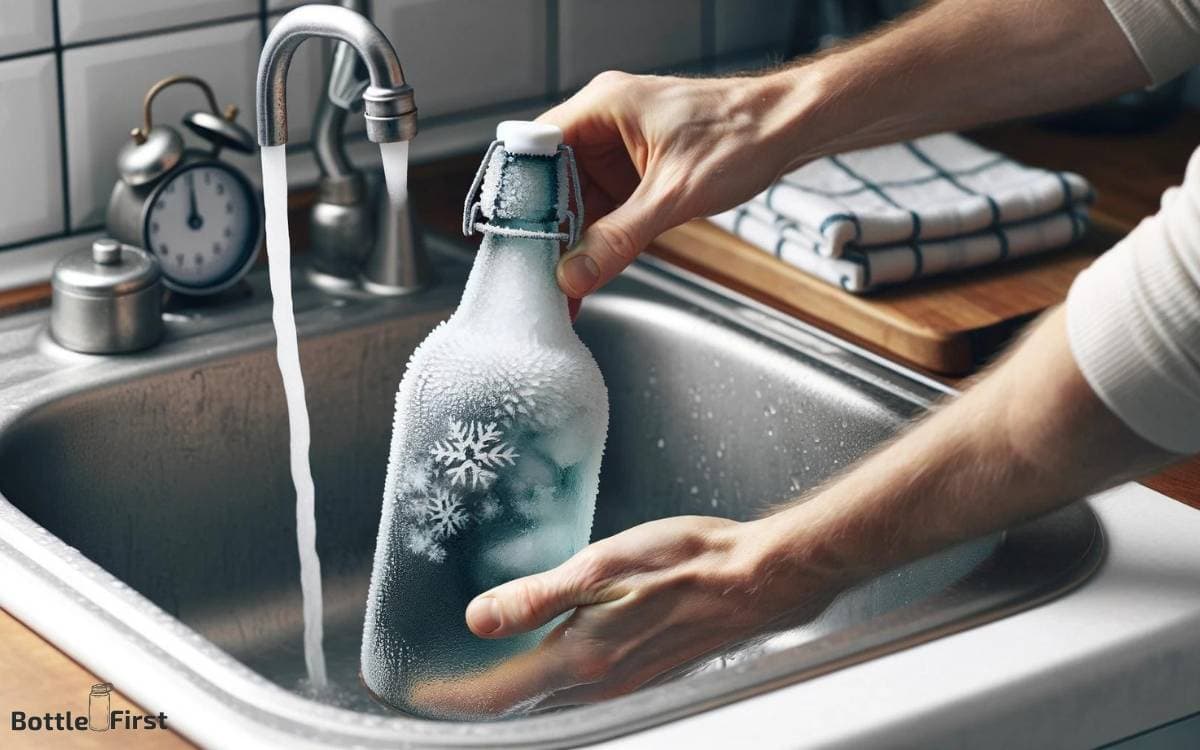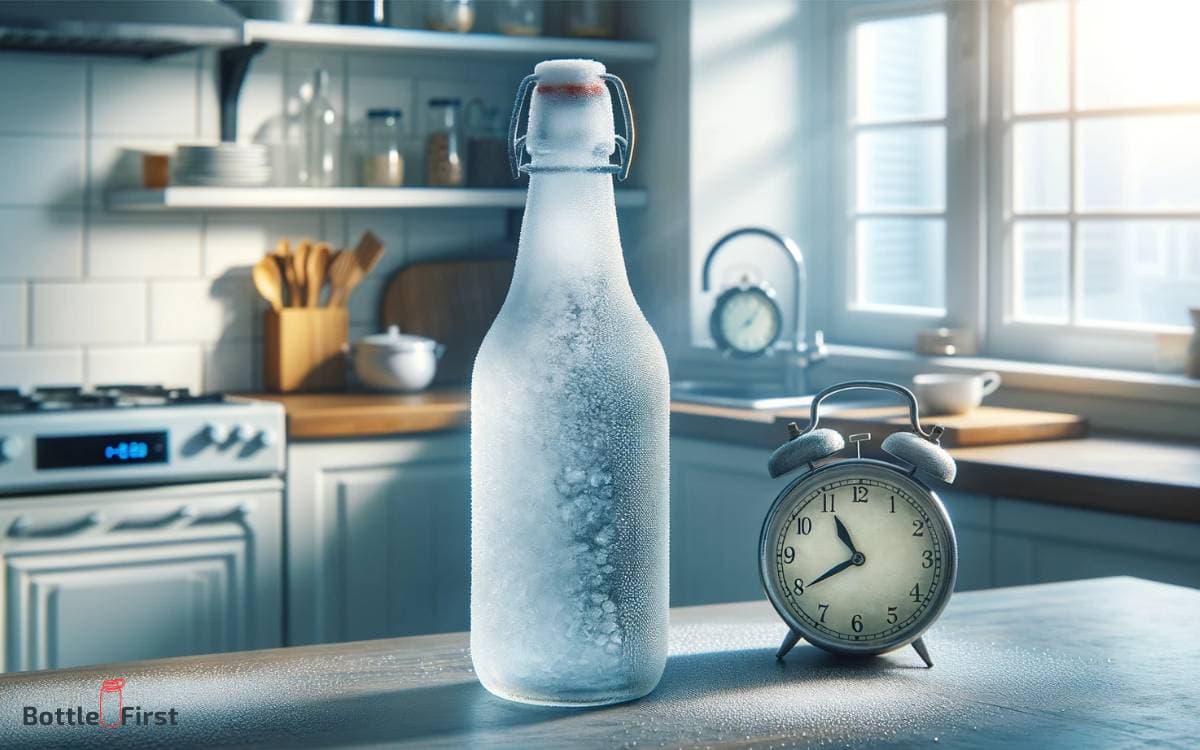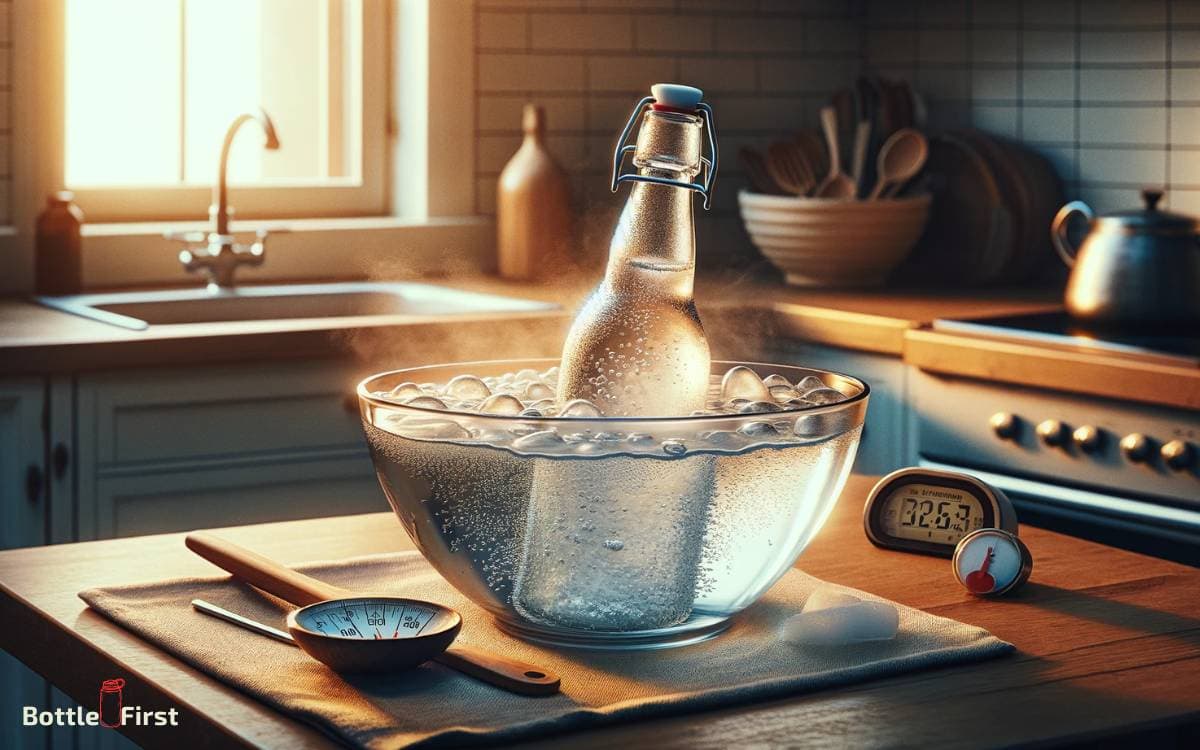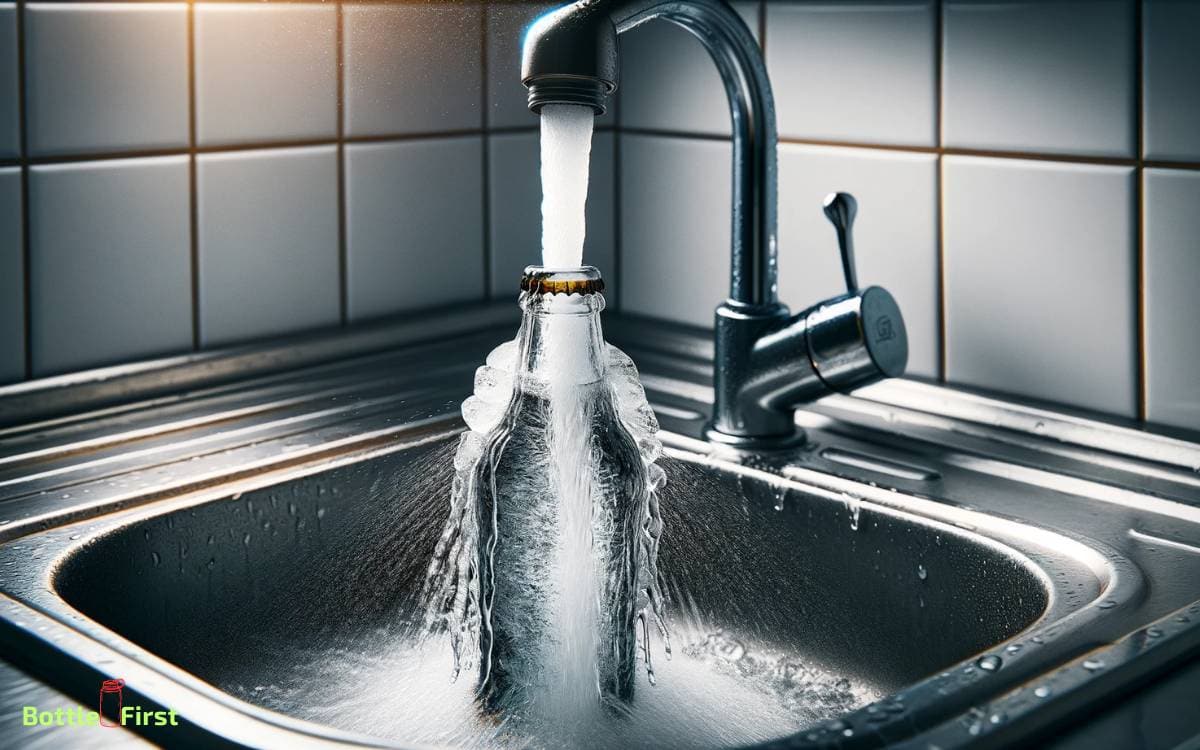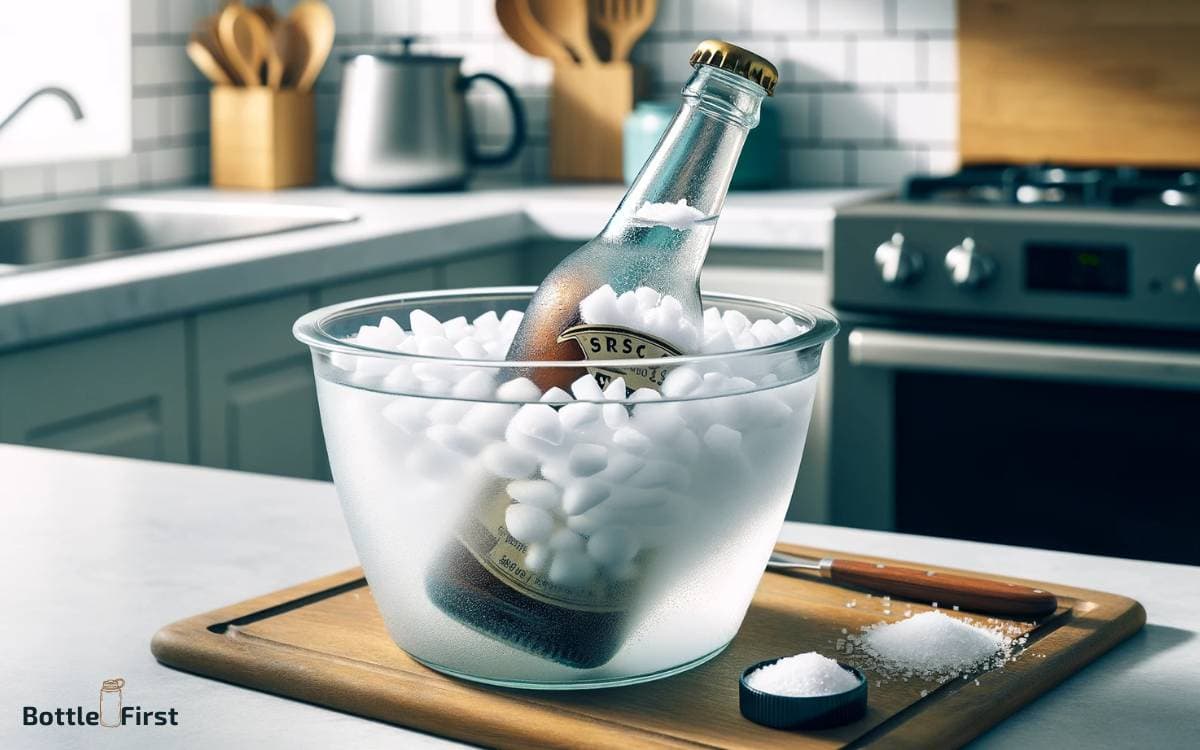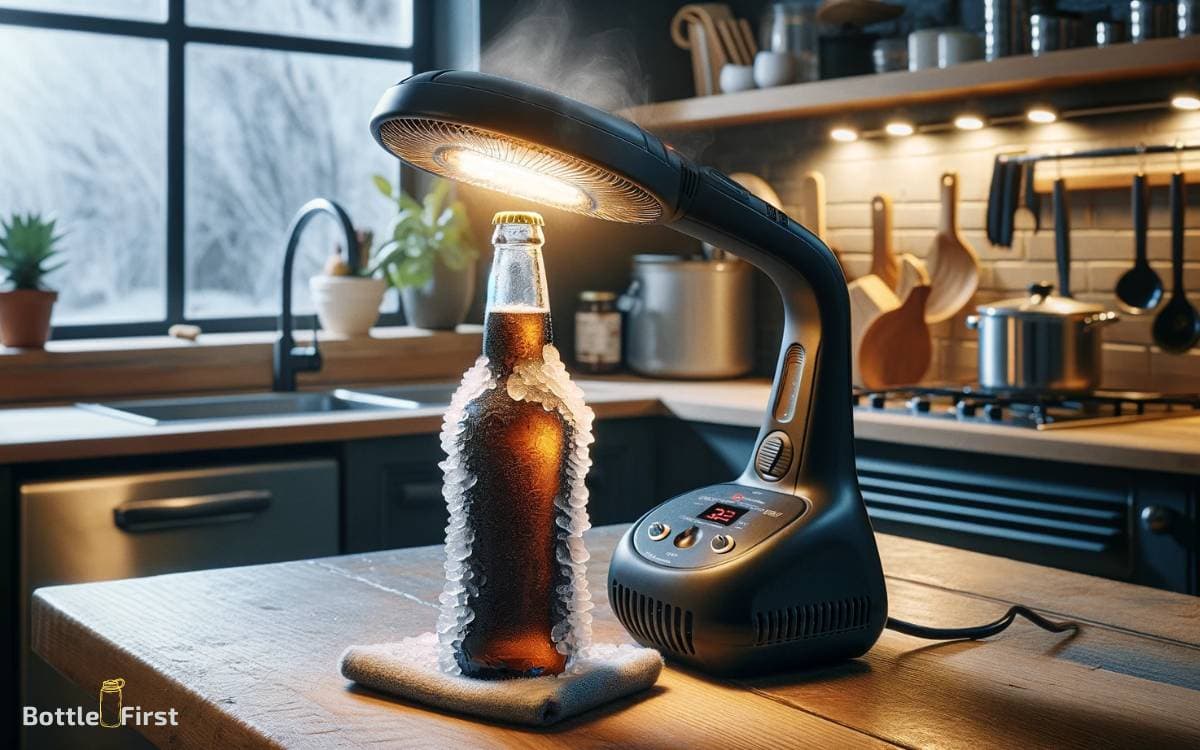How to Thaw a Frozen Glass Bottle? 7 Easy Steps!
Thawing a frozen glass bottle carefully can prevent it from breaking due to rapid temperature changes.
To safely defrost your glass bottle, you can employ gentle methods such as refrigeration, cold water baths, or gradual room temperature adjustment.
Avoid using direct heat sources like hairdryers as they can increase the risk of the glass shattering.
When glass is exposed to sudden temperature shifts, it can crack or break due to thermal shock. This happens because the material expands or contracts unevenly.
Here are some quick steps:
Safely thaw your frozen glass bottle by employing gradual warming techniques to avoid breakage and enjoy your drink intact.
Key Takeaway
Step 1: Room Temperature Thawing
To thaw a frozen glass bottle at room temperature, you should place it on the counter and let it gradually come to a safe temperature.
This method is simple yet effective, allowing the glass bottle to slowly acclimate to the surrounding environment. As the bottle warms up, it reduces the risk of cracking or shattering due to sudden temperature changes.
This approach is ideal for preserving the integrity of the contents within the bottle, whether it’s a rare wine or a homemade sauce.
By using this room temperature thawing technique, you’re embracing a more natural and gentle method that prioritizes the safety of the glass bottle and its contents.
It’s an innovative way to thaw frozen glass bottles without compromising their quality.
Step 2: Warm Water Bath Method
Place the frozen glass bottle in a bowl or sink filled with warm water, allowing it to thaw gradually and safely.
This method continues the process of gentle thawing, minimizing the risk of thermal shock and preserving the quality of the bottle’s contents.
Here are four key benefits of using the warm water bath method:
- Efficiency: The warm water accelerates the thawing process, allowing you to enjoy the contents of your bottle sooner.
- Preservation: By thawing the bottle gradually, the risk of thermal shock is minimized, ensuring that the contents remain unaffected.
- Safety: This method reduces the likelihood of the glass bottle cracking or breaking due to sudden temperature changes.
- Control: You can easily monitor the thawing process and ensure that the bottle thaws evenly and without damage.
Step 3: Running Water Technique
If you’re in a hurry to thaw a frozen glass bottle, the running water technique is a quick and effective method.
Simply place the frozen bottle under running water, and watch as the ice melts away.
Not only does this method save time, but it also conserves water usage compared to other thawing methods.
Quick and Effective Method
You can quickly and effectively thaw a frozen glass bottle using the running water technique.
Here’s how:
- Turn on the Tap: Run lukewarm water over the frozen bottle.
- Rotate the Bottle: Ensure the water covers the entire surface of the bottle.
- Use Your Hands: Gently rotate and shake the bottle to help distribute the warmth.
- Check for Progress: After a few minutes, test the bottle to see if it has thawed.
This method allows for a rapid thaw while minimizing the risk of thermal shock to the glass. It’s perfect for those who seek efficient and innovative ways to solve everyday problems.
Once the bottle is thawed, it’s essential to consider ways to conserve water usage in the process.
Conserves Water Usage
Wondering how you can thaw a frozen glass bottle while conserving water usage with the running water technique? Here’s a brilliant solution for you!
Instead of letting the tap run continuously, fill a basin or large container with warm water. Submerge the frozen bottle in the water and let a slow stream of water flow into the container.
This way, the running water will circulate around the bottle, accelerating the thawing process without wasting excess water.
As the bottle thaws, gently rotate it to evenly distribute the warmth. Once the bottle is unfrozen, you’ve successfully conserved water while effectively thawing the glass bottle.
Now, let’s explore an alternative method using a rubbing alcohol solution to expedite the thawing process even further.
Step 4: Rubbing Alcohol Solution
To thaw a frozen glass bottle using a rubbing alcohol solution, first, gather a clean cloth and a bottle of rubbing alcohol.
Follow these steps to effectively thaw the bottle:
- Moisten the clean cloth with rubbing alcohol.
- Wrap the moistened cloth around the frozen part of the glass bottle.
- Let it sit for a few minutes to allow the rubbing alcohol to lower the freezing point of the ice.
- After a few minutes, gently twist and pull the bottle to release it from the ice.
Using rubbing alcohol to thaw a frozen glass bottle is an innovative solution that can save time and reduce the risk of damaging the bottle. This method leverages the unique properties of rubbing alcohol to efficiently and safely thaw the bottle.
Step 5: Saltwater Submersion
You’ll find that saltwater submersion can be a highly effective method for thawing a frozen glass bottle. The salt lowers the freezing point of water, which speeds up the thawing process.
Depending on the size of the bottle and the amount of salt used, it may take around 30 minutes to an hour for the bottle to fully thaw.
Effectiveness of Saltwater
To effectively thaw a frozen glass bottle, immerse it in saltwater for maximum efficiency. Saltwater is a highly effective medium for thawing frozen glass bottles due to its unique properties.
Here’s why saltwater submersion is so effective:
- Thermal Conductivity: Saltwater has higher thermal conductivity than regular water, allowing it to transfer heat more efficiently to the frozen bottle.
- Lower Freezing Point: The addition of salt to water lowers its freezing point, preventing the saltwater from turning into ice and enabling it to remain in liquid form at lower temperatures.
- Speed: Saltwater can thaw frozen bottles more quickly than other methods, saving you time and effort.
- Uniform Thawing: Immersion in saltwater ensures a more uniform thaw, reducing the risk of thermal shock and potential damage to the glass bottle.
Time for Thawing
When thawing a frozen glass bottle through saltwater submersion, the time required for complete thawing can vary depending on the size and thickness of the bottle.
The innovative method of using saltwater to thaw a frozen bottle can significantly reduce the time compared to traditional thawing methods.
The salt lowers the freezing point of the water, allowing it to remain in a liquid state even at temperatures below 0°C (32°F).
For smaller and thinner glass bottles, the thawing process may take around 15-20 minutes, while larger and thicker bottles may require 30-40 minutes for complete thawing.
It’s important to periodically check the bottle during the thawing process to ensure it isn’t left in the saltwater for longer than necessary, as this may affect the temperature and integrity of the glass.
Step 6: Hairdryer Thawing Method
How quickly can you thaw a frozen glass bottle using a hairdryer?
With the hairdryer thawing method, you can quickly and safely thaw a frozen glass bottle in just a few minutes.
Here’s how to do it:
- Plug in the hairdryer: Get your hairdryer and plug it into a power outlet.
- Set it to low or medium heat: Adjust the heat setting to low or medium to prevent the glass from cracking due to sudden temperature changes.
- Hold the hairdryer 6-8 inches away from the bottle: Keep a safe distance to evenly distribute the heat and prevent hot spots.
- Move the hairdryer around the bottle: Continuously move the hairdryer around the bottle to ensure all areas are heated evenly.
This innovative method provides a quick solution for thawing frozen glass bottles without the risk of breakage.
Step 7: Using a Portable Heat Source
After you have considered the hairdryer method, you may want to explore using a portable heat source to quickly and safely thaw a frozen glass bottle.
Portable heat sources offer innovative and efficient ways to thaw a frozen glass bottle, making them a valuable tool for anyone facing this issue.
Here’s a comparison of different portable heat sources to help you make an informed decision:
| Heat Source | Pros | Cons |
|---|---|---|
| Hot Water Bath | Thaws evenly | Time-consuming |
| Heating Pad | Gentle and controlled heat | Requires electricity |
| Chemical Heat Pack | No electricity needed | One-time use only |
These portable heat sources provide alternative methods for thawing a frozen glass bottle, offering convenience and innovation to the process. Choose the one that best fits your needs and conditions.
Conclusion
Thawing a frozen glass bottle can be done using various methods like:
- Room temperature thawing
- Warm water bath
- Running water technique
- Rubbing alcohol solution
- Saltwater submersion
- Hairdryer thawing
- Portable heat source
Each method has its own benefits and drawbacks, so choose the one that works best for you. Remember to handle the glass bottle with care to avoid breakage.
With patience and the right technique, your bottle will be thawed and ready to use in no time.
